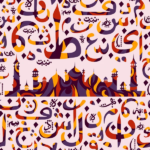|
| Arabic calligraphy plays an important role in Arabic writing. The art of writing Arabic correctly is a noble art which is appreciated throughout the world. |
| As well as being the way of writing Arabic script, words and phrases, Arabic calligraphy shines a light on Islamic society. This art is deemed worthy of putting into writing the verses of the Holy Quran as well as eulogies to praise the glory of Allah, Muhammad, salvation, and the Islamic liturgy. |
| Learning Arabic calligraphy increases a student’s graphic skills. The attention he or she brings to the beautiful curves and rounded shapes of the letters encourage stylistic awareness of Arabic writing. |
| Of course, while learning Arabic calligraphy, one can’t help learning the Arabic alphabet and recognizing the linguistic richness of the language as well. The Arabic alphabet contains 27 letters in addition to the hamza, 117 letter forms dictated by their positions in Arabic words (isolated, initial, middle, or final). |
- Over 60,000 Arabic vocabulary words
|
- 6,000 verb roots from which adjectives are derived
|
- An infinite amount of various circumlocutions (wordy synonyms).
|
|
|
| Why is Arabic Written from Right to Left? |
| Arabic and European languages are read in opposite directions, but why is this? |
| Nothing happens by chance. |
| The reason for the direction in which Arabic is written can be found in the history of ancient civilizations. |
| Originating in ancient Mesopotamia in the fourth century BCE, the first writing system was composed of cuneiform characters (in the Middle East) and hieroglyphs (in ancient Egypt) around 3500 BC. |
| Through the ages, vast empires merged and standardized their oral communication system by creating a Proto-Sinaitic alphabet around 1400 BC. The first examples of this alphabet were found on a dagger in Lachish, in Palestine. |
| Read from right to left, this alphabet contained 23 signs in the form of Egyptian hieroglyphs. |
| By the 10th century, the Phoenician empire – a vast kingdom of Lebanese origin that dominated the Mediterranean basin for nearly 1000 years BC – had spread Canaanite languages throughout the Mediterranean. |
| They had transformed their spoken phonemes and consonants into a written alphabet of 22 letters that proceeded from right to left. |
| This writing system based on three-letter consonant combinations would evolve into all of the known Semitic language alphabets including Akkadian, Syriac, Aramaic, Arabic, and Hebrew, and would eventually lead to the formation of Greek and Latin. |
| There is no need to review the complete history of writing. But, it is good to remember that the Phoenician language is the ancestor of the Aramaic alphabet, the language spoken by Jesus Christ, to which the Arabic alphabet can trace its origin sometime during the second century. |
| In short, Arabic is written from right to left because of its Aramaic linguistic origins. |
| But, we don’t quite understand yet WHY the people of Arabia began writing from the right. |
| We currently only have a collection of hypotheses about the direction in which Arabic is written. |
- The type of material used at the time (reed, stone, etc.)
|
- The hand used to carve the stone (there have always been more right-handed people than left-handed people)
|
- The direction in which documents were unrolled in ancient Egypt. Egyptian scribes unrolled papyrus scrolls with the left hand in order to read and write toward the left.
|
- The desire to imitate the writing of ancestors. Each civilization inherited the skills of those that came before.
|



